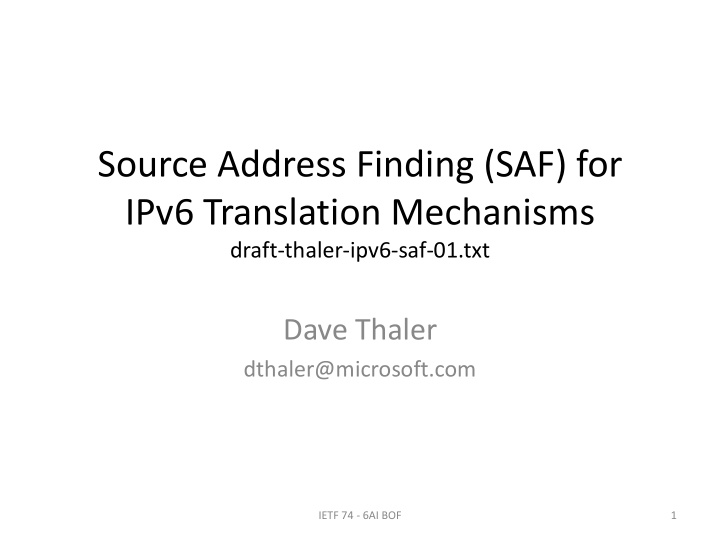



Source Address Finding (SAF) for IPv6 Translation Mechanisms draft-thaler-ipv6-saf-01.txt Dave Thaler dthaler@microsoft.com IETF 74 - 6AI BOF 1
UNilateral Self-Address Fixing (UNSAF) • 1:1 address mappings (NAT66) avoid most of the issues with NAT, except: – Address seen by other end is different from what is seen locally • Many apps break when both ends don’t see the same address • IAB RFC 3424 (November 2002) defined “UNSAF”: – UNSAF mechanisms learn the address others see you as – endpoint “fixes” up the address it reports/advertises, since it’s different from what the endpoint originally thought – UNSAF mechanisms “can be considered at best as short term fixes ” – UNSAF mechanisms require an exit strategy • Previously it was “IPv6”, but not if we end up with NAT66… IETF 74 - 6AI BOF 2
SAF = Source Address Finding • Can regain end-to-end transparency if 1. Use reversible 1:1 translation between host and NAT66 2. Learn (“find”) the external address and assign it to a virtual interface in the host • Compare vs tunnel-with-header-compression – Same: no changes to TCP/IP, sockets, apps required – Different: allows single-box deployment (at expense of losing e2e transparency) as a deployment step IETF 74 - 6AI BOF 3
Incremental deployment (1/2) • Someone drops in 1 or more IPv6 Internet NAT66 boxes • Some apps work X::Y (same that work through NAT44) NAT66 NAT66 • Some apps break • Network still sees A::B some benefit • Hosts still see JL JL some pain IETF 74 - 6AI BOF 4
Incremental deployment (2/2) • Upgrade hosts • Host finds X::Y IPv6 Internet • Host adds it on X::Y virtual interface NAT66 NAT66 • TCP/IP uses it normally • VIf translates X::Y A::B NAT66 NAT66 to A::B, NAT66 Vif(s) Vif(s) X::Y JJ JJ translates it back IETF 74 - 6AI BOF 5
SAF Mechanisms • A “SAF” mechanism is one that learns the information needed to configure the virtual interface • Discussion of actual mechanisms is out of scope for this document and presentation – But it’s not rocket science – No per-flow negotiation needed since address is flow- independent – Need not involve changes to NAT66 devices • Discussion of architectural constraints is in scope IETF 74 - 6AI BOF 6
Requirements for SAF Mechanisms 1. MUST find external addresses (and other config) 2. SHOULD work even if network beyond NAT66 is unreachable 3. MUST learn Valid/Preferred lifetimes of addrs 4. MUST NOT require a separate external address per translator 5. SHOULD support RFC3041 (privacy) addrs 6. SHOULD support CGAs IETF 74 - 6AI BOF 7
Recommend
More recommend